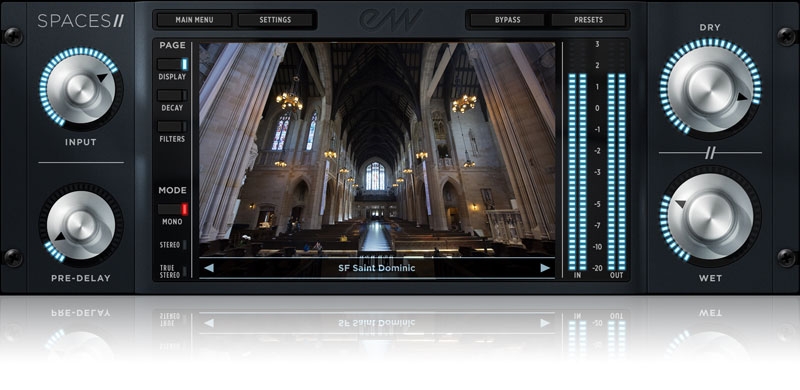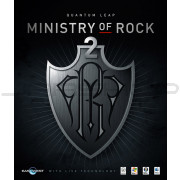You're currently on:

The Sequel to the Ultimate Convolution Reverb
SPACES II from EASTWEST is the highly-anticipated sequel to SPACES I, the top-selling convolution reverb engine endorsed by top industry professionals which set a new standard in impulse recording techniques. Produced by Doug Rogers and Nick Phoenix, SPACES II includes 353 brand new reverbs recorded in churches, concert halls, opera houses, catacombs, train stations, recording studios, and warehouses. It includes a new streamlined user interface, new control features, a vastly expanded collection of instrument specific reverbs, plus all of the reverbs from SPACES I, making SPACES II the most powerful and versatile convolution reverb engine on the market.
Instrument Specific Reverbs
A unique feature of SPACES II is the instrument specific reverbs that have been designed to take the guesswork out of instrument reverb selection. Only the SoCal hall was recorded using this method in SPACES I and it was so popular six venues with instrument specific reverbs are now included in SPACES II. How was this done? An ATC speaker array was created to emulate the sound projection patterns of each instrument or section. For orchestral halls, a recording was taken in the exact position an instrument would be on stage. A french horn fires its sound backwards against the back wall, therefore, an impulse for a french horn was created by firing the sweep tones from the middle to left rear of the stage, backwards and slightly towards the floor. 1st violin section recordings were taken by firing a series of speakers at an angle toward the ceiling, just like a real section, with a fifth speaker firing towards the floor to emulate the body of the violins. A choir shoots straight out from the back, a celeste or harp is usually way over to the side and a lot of that sound goes up giving you early reflections. Most soundtrack composers that use SPACES I consider those instrument reverbs from the SoCal Hall to be ground breaking. Set up a mixing template with unique reverb for the strings, brass, winds, percussion and choir and something magical happens. In SPACES II five more venues were added using this technique for a total of six venues. There are 324 instrument specific reverbs in SPACES II compared to 48 in SPACES Ifor a total of 372. It took a massive effort, but the results speak for themselves.
Brand New Spaces
From stunning concert venues like Abravanel Hall in Salt Lake City, Reynolds Hall in Las Vegas, and the War Memorial Opera House in San Francisco, to exquisite sounding churches like St. Patrick’s and St. Dominic’s, to unique and extraordinary sounding locations like catacombs and Union Station in Los Angeles, the reverbs from these brand new spaces will inspire you and help bring your compositions to life with incredible realism. These are some of the best locations EastWest has recorded in and they will all perfectly compliment the locations from SPACES I.
New Streamlined User Interface + New Control Features
SPACES II features a streamlined, completely re-vamped user interface. Now the user can actually see visuals of each space - including those from SPACES I! In additional, new Next / Previous arrows allow the user to easily navigate the 1,020 reverbs from this massive collection. The biggest new feature is a brand-new Decay Time panel. Now you’ll have absolute control of the decay time of each and every space, allowing for the ultimate in customization.
Same Revolutionary Recording Techniques
The same revolutionary impulse recording techniques that made SPACES I so popular have been replicated in this new collection. The best gear from Fairchild, Manley, Meitner, Neumann, Neve, Sennheiser, Sony, Telefunken, and TG were used in each recording. ATC Monitors were used in each space to emulate the real-world sound projection properties of various instruments. SPACES II includes a very hi-resolution, True Stereo engine that focuses on delivering the very best sound at a very low CPU load. Most impulses are in 8 channel format, so surround mixes can be created.
FEATURES
Produced by Doug Rogers and Nick Phoenix
Technical Information
Generally, all info related to the reverb selected is displayed in the interface window of SPACES II.
The following is useful information -
M-S: means mono in and stereo out. So normal stereo reverb, where the input is summed to mono before being processed.Typically an impulse is taken with the source on the left side of the stage and the right side of the stage. Each impulse is stereo. When they are put together you get a true stereo 4 channel snapshot of the space. We encourage users to use the true stereo versions of the impulses. The true stereo switch on the interface is an indicator, not a switch. It indicates what you have loaded.
FR: means front mics.System Requirements
Below are the minimum and recommended hardware requirements for using SPACES II on your computer. Please see the Play User 6 Manual for a complete list of the Hardware and Software Requirements for installing and running any Play Library.
MAC MINIMUM REQUIREMENTS Intel Core 2 Duo Processor 2.7GHz or higher8GB RAM Mac OSX 10.7 or later 7200 RPM or faster (non energy saving) hard drive for sample streaming | PC MINIMUM REQUIREMENTS Intel Core 2 Duo, or AMD Dual Core 2.7GHz or higher8GB RAM Windows 7 or later Sound card with ASIO drivers 7200 RPM or faster (non energy saving) hard drive for sample streaming |
MAC RECOMMENDED SYSTEM Mac Pro Late 2013 edition (current model with round enclosure) or above16GB RAM or more Mac OSX 10.7 or later SSD (Solid State Drive) for sample streaming | PC RECOMMENDED SYSTEM Intel Xeon E5 (or equivalent) running at a minimum of 2.7 GHz (or above)16GB RAM or more 64-bit Windows/Host Sequencer Sound card with ASIO drivers SSD (Solid State Drive) for sample streaming |
Please Note! The 32-bit stand-alone and plug-in components are no longer installed because PLAY 5 and later does not support 32-bit Operating Systems or DAWs.
EASTWEST PLAY Host/Sequencer Compatibility Matrix
| Tested DAW | Mac OS 10.9 - 10.12.3 | WIN XP (32-bit) | WIN XP (64-bit) | WIN 10, 8, 7, Vista (32-bit) | WIN 10, 8, 7, Vista (64-bit) | Required Version |
|---|---|---|---|---|---|---|
| Standalone | YES | YES | YES | YES | YES | |
| Ableton Live | YES | YES | YES | YES1 | 6.07 or higher | |
| Cubase/Nuendo | YES2 | YES | YES3 | YES | YES3 | 6 or higher |
| FL Studio | YES | YES | YES | YES | 7 or higher | |
| GarageBand | YES | 3 or higher | ||||
| Logic | YES4 | 7.2 or higher | ||||
| Digital Performer | YES4 | YES | YES | 6.02 or higher | ||
| Pro Tools5 | YES | YES | YES | 7.4 to 10 | ||
| Pro Tools 11 or higher5 | YES | YES | YES6 | 11 or higher | ||
| Sibelius | YES7 | YES | YES | 6 or higher8 | ||
| Sonar | YES | YES | YES | YES | 6.2 or higher | |
| VE Pro | YES | YES | YES | YES | YES | 4.0.54 or higher |
| Studio One | YES | YES | YES | YES | YES | 2 or higher |
| Reaper | YES | YES | YES | YES | YES | 3 or higher |






















